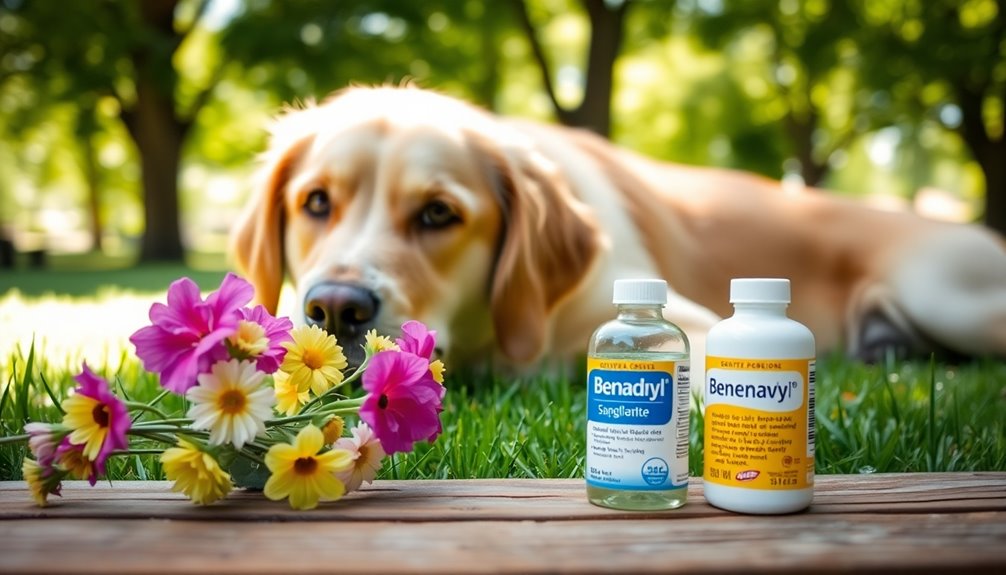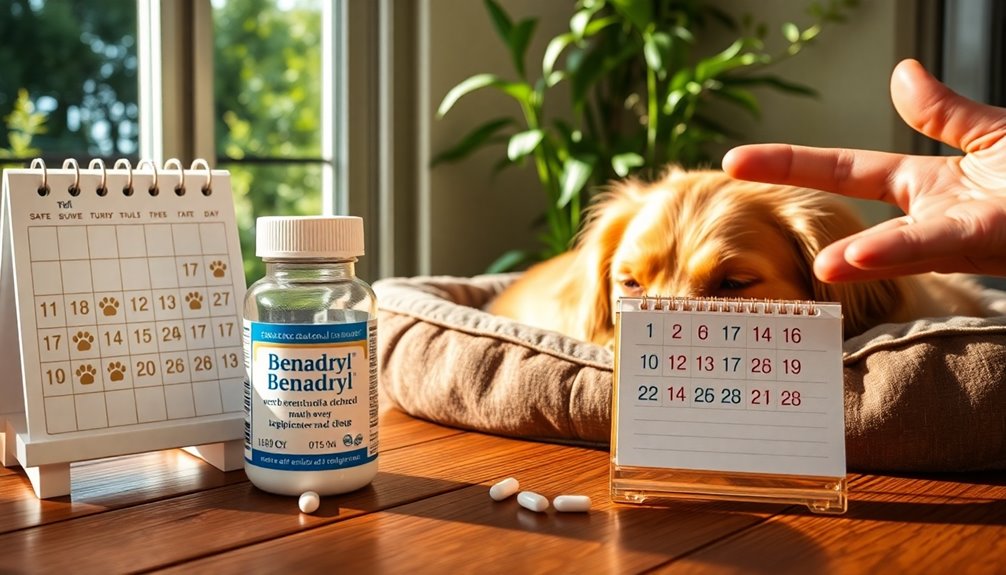You can give your dog Benadryl 2-3 times a day, depending on their weight and symptoms. Aim for about 1 mg per pound of body weight, and space doses about 8-12 hours apart. For dogs under 10 lbs, consult your vet for the right liquid dosage. Larger dogs can receive up to 100 mg. Always monitor your dog for any adverse reactions, like vomiting or unusual behavior, and consult your vet if you have concerns, especially for long-term use. There's plenty more to learn about safe Benadryl administration and alternatives that might suit your pup better.
Key Takeaways
- Administer Benadryl 2-3 times daily based on your dog's symptoms and weight.
- Recommended frequency is every 8-12 hours for optimal effectiveness.
- Aim for a dosage of 0.9-1.8 mg per pound per administration.
- Monitor your dog for any adverse reactions after giving Benadryl.
- Consult your veterinarian for long-term use and dosage adjustments.
Understanding Benadryl for Dogs

When your dog experiences mild allergic reactions, you might consider using Benadryl, which contains diphenhydramine. This medication can effectively alleviate symptoms like itching and nausea.
However, it's vital to guarantee you're administering a safe dosage. Generally, you should give your dog between 2-4 mg per kg of body weight, with 1 mg per pound being a common guideline. You can typically administer Benadryl 2-3 times a day, but always consult your veterinarian first.
Be cautious to avoid any formulations that contain decongestants or alcohol, as these can be harmful to dogs. After giving Benadryl, monitor for any side effects, such as drowsiness or dry mouth, to guarantee your dog's safety and comfort.
Recommended Dosage Guidelines

Understanding the recommended dosage guidelines for Benadryl is essential for ensuring your dog's safety. The standard dosage is 2-4 mg per kg of body weight, which translates to approximately 0.9 to 1.8 mg per pound. Consult your veterinarian for personalized advice, especially considering individual health conditions.
| Dog Weight (lbs) | Recommended Dosage (mg) | Dosage Form |
|---|---|---|
| Under 10 | Liquid, per vet advice | Liquid Form |
| 10-25 | 10-50 | 25 mg Tablets |
| 26-50 | 25-50 | 25 mg Tablets |
| 51+ | 50-100 | 25 mg Tablets |
Most dogs can safely receive Benadryl 2-3 times daily for allergic reactions, but always prioritize safe administration based on veterinary guidance.
Frequency of Administration

You might wonder how often you can safely give your dog Benadryl to alleviate symptoms.
Generally, you can administer it 2-3 times daily, depending on the severity of your dog's symptoms and under your veterinarian's guidance. The recommended frequency is every 8 to 12 hours for effective management.
For proper dosage, you should aim for 0.9 to 1.8 mg per pound of your dog's weight per administration. It's important to monitor how your dog responds and consult with your veterinarian for any necessary adjustments in frequency or dosage.
If you plan on using Benadryl long-term, discussing it with your veterinarian is essential to evaluate ongoing safety and efficacy in treating your dog's symptoms.
Safety Considerations

While Benadryl can be an effective solution for managing allergy symptoms in dogs, ensuring its safe use is essential.
Before you give it to your dog, consult your veterinarian to confirm it's safe, especially if your pup has any health conditions or is on other medications.
Stick to the general guideline of 1 mg per pound of body weight, and don't exceed 2-3 doses per day, spaced 8 to 12 hours apart.
Monitor your dog closely for any adverse reactions, like vomiting or unusual behavior. If these occur, stop using Benadryl immediately and consult your vet.
Long-term use without veterinary oversight can pose risks, so always follow the recommended guidelines for frequency and dosage.
Alternatives to Benadryl

If you're looking for alternatives to Benadryl for managing your dog's allergies, several effective options exist.
Cetirizine (Zyrtec) and loratadine (Claritin) are popular antihistamines that might suit your dog's needs better, but you should always consult with your veterinarian first.
Non-medication options can also help alleviate allergy symptoms in dogs; consider dietary changes, medicated shampoos, and supplements to boost their health.
If anxiety contributes to your dog's allergies, behavioral modification techniques or prescription anti-anxiety medications may provide more effective relief than Benadryl.
Keep in mind that continuous research is being conducted on new treatments for pet allergies, which may offer improved results compared to traditional antihistamines.
Always guarantee you're making informed choices for your furry friend's wellbeing. Additionally, incorporating nutrient-rich natural ingredients into your dog's diet may enhance their overall health and resilience against allergens.
Frequently Asked Questions
How Often Can I Safely Give My Dog Benadryl?
You can typically give your dog Benadryl every 8 to 12 hours, but it depends on their symptoms.
For mild to moderate allergic reactions, you might administer it 2-3 times daily, keeping in mind their weight.
Always consult your vet first to get a tailored dosage and frequency suited for your dog's needs.
If you notice any adverse reactions, don't hesitate to reach out to your vet for guidance.
Can You Give Benadryl Every 4 Hours?
Think of Benadryl like a double-edged sword; it can soothe your dog's allergies, but misuse can lead to harm.
Giving Benadryl every 4 hours isn't recommended unless your vet says so. Regular dosing should happen every 8 to 12 hours, ensuring safety and effectiveness.
Always keep an eye on your dog's response, and if you think they need more, consult your veterinarian first to avoid any dangerous side effects.
Can Long Term Use of Benadryl Be Harmful to Dogs?
Long-term use of Benadryl can be harmful to your dog. You might notice side effects like drowsiness, dry mouth, or urinary retention.
Continuous administration may mask underlying health issues that need attention. Additionally, your dog could develop a tolerance, making the medication less effective over time.
Regular check-ups with your vet are essential to monitor for adverse reactions and guarantee safe treatment. Always consult your vet before considering long-term use.
How Often Can You Give Dogs Antihistamines?
Imagine steering through a stormy sea; sometimes your dog needs a soothing hand to calm the waves. Antihistamines can help when allergies become rough waters.
You can give these medications 2-3 times daily, depending on your dog's weight and your vet's advice.
Always remember, every dog's a unique sailor, so monitor their reaction closely after each dose. When in doubt, consult your vet for smooth sailing and safety on this journey.
Conclusion
In conclusion, giving your dog Benadryl can be a safe and effective way to manage allergies and anxiety when done correctly. Just remember to stick to the recommended dosage and frequency to keep your furry friend happy and healthy. Think of it as a comforting hug on a stressful day—sometimes, a little relief can make all the difference. Always consult your vet first to guarantee your pup's safety and well-being. Your dog deserves the best!









